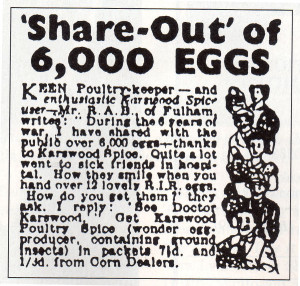
Between the wars England could have been described as either a nation of shopkeepers or poultry-keepers. Those were the days, before factory farming, when thousands of householders kept a few hens in their back gardens or allotments in an effort to supply their own requirements or perhaps supplement a meagre income.
Evidence of the extent of this cottage industry could be seen on station platforms where cardboard boxes, with holes punched in the sides, awaited despatch to their new owners. The occupants of such boxes could also be heard as they chirped away blissfully aware of their location or ultimate destinations. ‘DAY-OLD CHICKS’, usually printed in heavy red lettering, was the clearest visual indication of the contents. The message was perhaps intended to convey to the station porters (who were probably poultry-keepers themselves) the urgency of putting them on the first available train.
Domestic poultry-keeping during the wars was an art rather than a science, much of the feed consisting of household scraps supplemented with the occasional handful of balancer meal. However a most enterprising firm detected a gap in the market and launched a product which for many years enjoyed remarkable success. This proprietary brand, sold nationwide, was known as Karswood Poultry Spice.
It was widely available from most corn chandlers, pet shops and so on, and was prepacked in a variety of weights. The contents of these packets had all the appearance of sawdust, but it was the spicy pungent aroma which added to its mystique.
“Increase your egg yield” and “Keep your poultry in tip-top condition” were but two of the claims made in the extensive advertising campaign, conducted at relatively modest cost using a scheme known as syndicated classified advertising. For an outlay of only a few pounds it was possible to run an identical advertisement in the classified columns of hundreds of weekly local newspapers, so long as the booking was made for a minimum of two months. This service enabled a product to obtain nationwide exposure for relatively little cost, and the manufacturers of Karswood Poultry Spice used this medium with great success.
Some of the more enterprising poultry keepers could turn their hobby into ‘a nice little earner’, as Arthur Daley would say. It wasn’t unknown for them to buy cheap imported eggs and then erase the import markings with the aid of a damp cloth and some Vim. These eggs, ideally with a bit of straw stuck to them, were put in with their own fresh eggs and sold at a premium price. One budding tycoon had a notice at the end of a half-mile-long lane leading to his hen run which advertised ‘Eggs 8d a dozen – today’s eggs lOd a dozen’. Unfortunately, after making the tedious journey, the buyer discovered that he only ever had ‘to-day’s’ eggs left as, with a wry smile the poultryman would inform the weary bargain-hunter that all yesterday’s eggs had been sold.
Sadly the domestic poultry-keeper is no longer with us, and neither is Karswood Poultry Spice, but the breeds that were kept, such as White Wyonndot and Light Sussex live on at rare breed animal farms.
Alan Thomas








